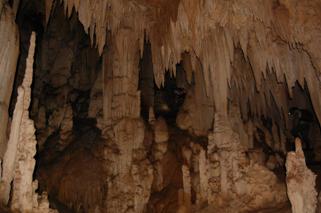Feb 11 2015
Scientists have produced a rainfall record strongly suggesting that man-made industrial emissions have contributed to less rainfall in the northern tropics.
 This image shows abundant stalagmites, stalactites and columns in Yok Balum Cave, Belize. Dr. Harriet Ridley is visible in the centre of the photo, and Dr. Keith Prufer is visible to the right. Credit: Dr. James Baldini, Durham University
This image shows abundant stalagmites, stalactites and columns in Yok Balum Cave, Belize. Dr. Harriet Ridley is visible in the centre of the photo, and Dr. Keith Prufer is visible to the right. Credit: Dr. James Baldini, Durham University
The research team, led by experts at Durham University, UK, reconstructed rainfall patterns stretching back more than 450 years by analysing the chemical composition of a stalagmite recovered from a cave in Belize, Central America.
They identified a substantial drying trend from 1850 onwards, coinciding with a steady rise in sulphate aerosols in the atmosphere as a result of burning fossil fuels to drive the industrial boom in Europe and North America.
Importantly they also identified nine short-lived drier spells in the northern tropics since 1550 following very large volcanic eruptions in the Northern Hemisphere that produced similar emissions as those produced by burning fossil fuels.
This provided very strong evidence that any injection of sulphate aerosols into the upper atmosphere could lead to shifts in rainfall patterns, the researchers said.
Writing in the journal Nature Geoscience today (Monday, February 9), the researchers said that sulphate aerosols moderated temperatures in the Northern Hemisphere by reflecting the Sun's radiation.
As a result the Intertropical Convergence Zone (ITCZ) - a tropical rainfall belt near the equator - shifted towards the warmer Southern Hemisphere leading to dryer conditions in the northern tropics.
The findings confirm previously published observations using 20th Century historical data and computer modelling, the researchers said.
Lead author Dr Harriet Ridley, from the Department of Earth Sciences at Durham University, said: "The research presents strong evidence that industrial sulphate emissions have shifted this important rainfall belt, particularly over the last 100 years.
"Although warming due to man-made carbon dioxide emissions has been of global importance, the shifting of rain belts due to aerosol emissions is locally critical, as many regions of the world depend on this seasonal rainfall for agriculture.
"The role of sulphate aerosols in repositioning the ITCZ was previously identified using computer modelling, but until now no suitable climate record existed to support those ideas.
"Our research allows us to make more accurate predictions about future climate trends and it appears that regional sulphate aerosol production is an essential factor to include in these predictions."
The researchers said their interpretations were made possible because of the quality of the stalagmite sample they obtained from the Yok Balum cave in Belize, which is located at the northernmost extent of the modern day ITCZ and is sensitive to changes in its position.
By analysing the isotope values of the stalagmite - where more negative values equal wet conditions and less negative values equal dry conditions - they were able to reconstruct rainfall.